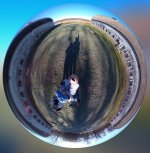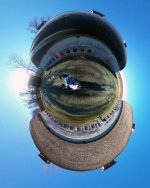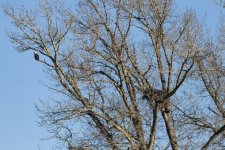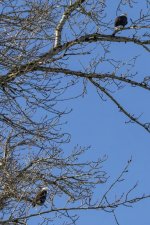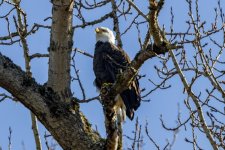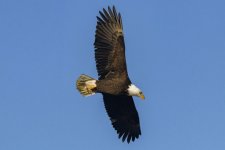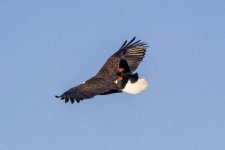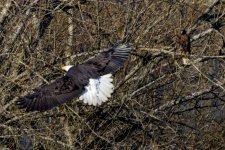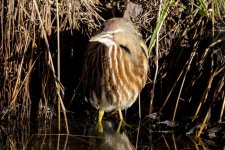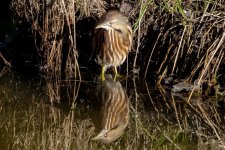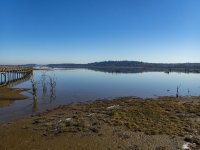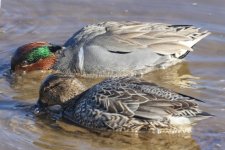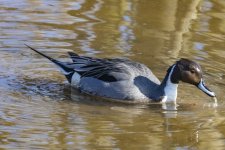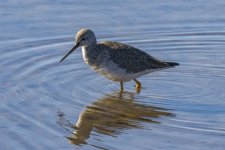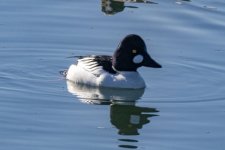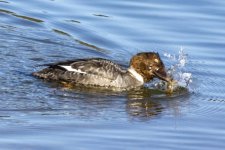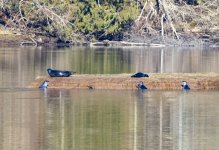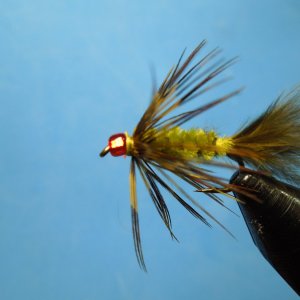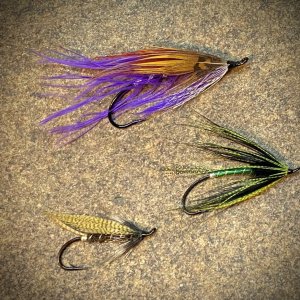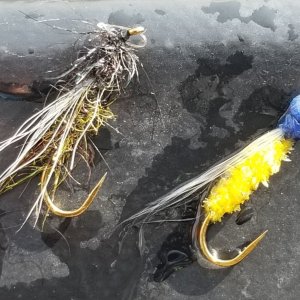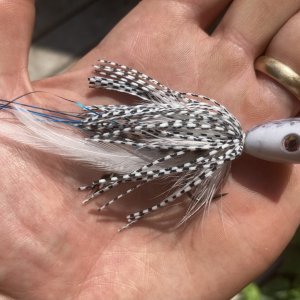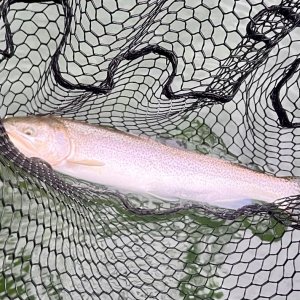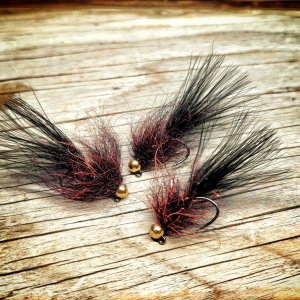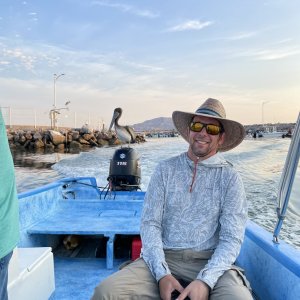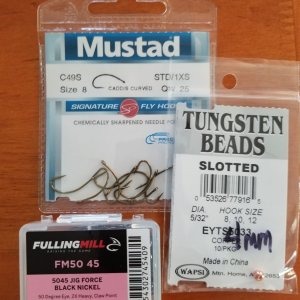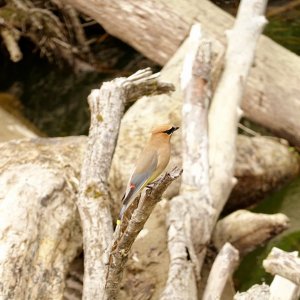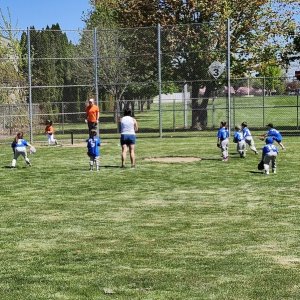Part 1 of 3. On Thursday evening, my wife and I looked at the weather and our joint schedules to see if we could squeeze in a part-day adventure on Friday. Schedules: check. Weather: cold but clear: check. Overnight temperatures dropped to the mid-teens and were still in the twenties, but with calm winds, when we left our house for the Billie Frank Jr. Nisqually Wildlife Refuge. I was a bit concerned as the fog was thick at the intersection of I-5 and Hwy. 101, but it cleared up as we went north and the skies were sunny and blue as we emerged at the crest of the hill that drops into the Nisqually Valley.
After parking and gearing up, we headed to the less-visited east ponds. My wife was hoping to see some brant geese and that spot sometimes holds waterfowl. But the ponds were dry. I like that stretch also for insectivores because the trees that line the service road receive early morning sun. But there was no one home in the tree either this morning.
Emerging by the start of the parking lot by the education center, we could hear birds calling in the alders. These proved to be a few ruby crowned kinglets, black-capped chickadees, and several yellow-rumped warblers. The warblers were really focused on breakfast and were very active (and therefore, very challenging to photograph among the branches).
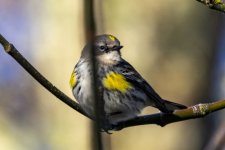
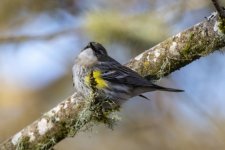
We walked back to the Norm Dicks Visitor Center. Much of the pond in front was frozen. A pair of mallards watched nervously as we passed by them via the walkway. From the viewing platform, we could see several groups of mallards in the open water. A subset paddled over toward us to feed on whatever had been caught in the melting ice at the end of the pond.
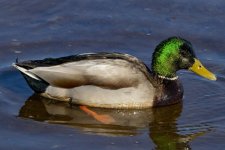
These were joined by a green-winged teal drake. Later, a group of ring-necked ducks worked their way closer as well. I picked up low-level nasal whistles coming from off to our right. In the binocs, a small flock of wigeons were feeding on new grass shoots at the edge of the pond.
We cut back through the parking lot to the shallow seasonal ponds the fill the meadows. Everything was frosty but there must have been something in the grassy meadows that attracted the attentions of foraging robins. A killdeer flew in to join the robins and another killdeer that was already foraging in the field.
The seasonal ponds/fields were mostly frozen to the south of the gravel road. A mixed flock of Northern shovelers, green-winged teals, Northern pintails, and wigeons were clustered in the two patches of open water or on the adjacent ice edge.
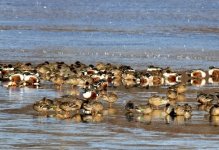
A flock of wigeons broke off from the resting birds and waddled carefully over the ice to the near edge of the pond to graze on grasses along the shoreline. One of these birds looked not like the others, a bird with a cinnamon head and a cream-colored crown. It was a male Eurasian wigeon, a rare visitor, most likely from eastern Russia. It was quite cooperative and I have some nice pictures with both the American wigeon drake and Eurasian wigeon drake in view.
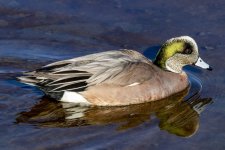
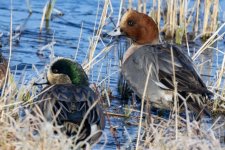
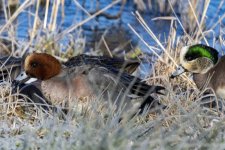
While we were watching the wigeons, several golden-crowned sparrows and song sparrows emerged from the cover of the blackberries to resume their search for breakfast. The golden-crowned sparrows are feeding on fresh grass shoots as you can see by the residue in the corner of its bill.
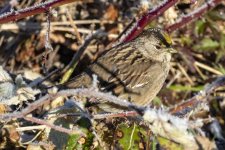
A spotted towhee joined the group. Further along the trail, a northern flicker was perched deep in the trees and a pair of Bewick’s wrens searched for lunch.
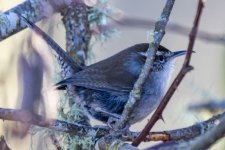
On our walk back to the Visitor Center, we encountered two brown creepers. They can be ephemeral, there and then gone. But both of these birds were more focused on combing the tree trunks and limbs for insects than our presence.

Steve
After parking and gearing up, we headed to the less-visited east ponds. My wife was hoping to see some brant geese and that spot sometimes holds waterfowl. But the ponds were dry. I like that stretch also for insectivores because the trees that line the service road receive early morning sun. But there was no one home in the tree either this morning.
Emerging by the start of the parking lot by the education center, we could hear birds calling in the alders. These proved to be a few ruby crowned kinglets, black-capped chickadees, and several yellow-rumped warblers. The warblers were really focused on breakfast and were very active (and therefore, very challenging to photograph among the branches).


We walked back to the Norm Dicks Visitor Center. Much of the pond in front was frozen. A pair of mallards watched nervously as we passed by them via the walkway. From the viewing platform, we could see several groups of mallards in the open water. A subset paddled over toward us to feed on whatever had been caught in the melting ice at the end of the pond.

These were joined by a green-winged teal drake. Later, a group of ring-necked ducks worked their way closer as well. I picked up low-level nasal whistles coming from off to our right. In the binocs, a small flock of wigeons were feeding on new grass shoots at the edge of the pond.
We cut back through the parking lot to the shallow seasonal ponds the fill the meadows. Everything was frosty but there must have been something in the grassy meadows that attracted the attentions of foraging robins. A killdeer flew in to join the robins and another killdeer that was already foraging in the field.
The seasonal ponds/fields were mostly frozen to the south of the gravel road. A mixed flock of Northern shovelers, green-winged teals, Northern pintails, and wigeons were clustered in the two patches of open water or on the adjacent ice edge.

A flock of wigeons broke off from the resting birds and waddled carefully over the ice to the near edge of the pond to graze on grasses along the shoreline. One of these birds looked not like the others, a bird with a cinnamon head and a cream-colored crown. It was a male Eurasian wigeon, a rare visitor, most likely from eastern Russia. It was quite cooperative and I have some nice pictures with both the American wigeon drake and Eurasian wigeon drake in view.



While we were watching the wigeons, several golden-crowned sparrows and song sparrows emerged from the cover of the blackberries to resume their search for breakfast. The golden-crowned sparrows are feeding on fresh grass shoots as you can see by the residue in the corner of its bill.

A spotted towhee joined the group. Further along the trail, a northern flicker was perched deep in the trees and a pair of Bewick’s wrens searched for lunch.

On our walk back to the Visitor Center, we encountered two brown creepers. They can be ephemeral, there and then gone. But both of these birds were more focused on combing the tree trunks and limbs for insects than our presence.

Steve
Last edited:

